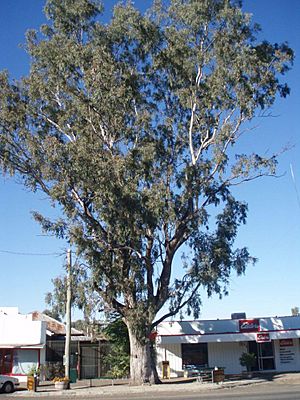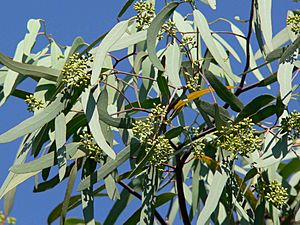Eucalyptus microtheca facts for kids
Quick facts for kids Coolibah |
|
|---|---|
 |
|
| Eucalyptus microtheca - Leichhardt Tree in Taroom | |
| Scientific classification | |
| Genus: |
Eucalyptus
|
| Species: |
microtheca
|
| Synonyms | |
|
|
The Eucalyptus microtheca, often called the coolibah, is a type of tree found only in northern Australia. It has rough bark on its trunk and branches. Its adult leaves are shaped like a spear. The tree produces groups of seven flower buds, which open into white flowers. Later, it grows round or cone-shaped fruits. You can find coolibah trees across a large area, from the Kimberley region in Western Australia all the way to Cape York in Queensland.
Contents
What the Coolibah Tree Looks Like
The coolibah tree is usually a medium-sized tree, growing about 5 to 10 meters (16 to 33 feet) tall. Sometimes, it grows as a "mallee," which means it has many stems coming from a woody base underground. This woody base is called a lignotuber.
The bark of the coolibah tree is whitish-grey to dark grey. It often looks like a box, with deep cracks or a flaky, puzzle-like pattern as the tree gets older.
Leaves, Flowers, and Fruit
Young coolibah plants have long, narrow leaves, about 5 to 15 centimeters (2 to 6 inches) long. Adult trees have dull green or bluish leaves that are shaped like a spear or slightly curved. These leaves are about 5 to 19.5 centimeters (2 to 7.7 inches) long.
The flowers grow in groups of seven. Each group is on a thin stalk. The flower buds are pear-shaped or oval, about 3 to 4 millimeters (0.12 to 0.16 inches) long. They have a rounded cap with a small point in the middle.
Coolibah trees usually flower between September and January. Their flowers are white. After flowering, the tree produces woody fruits. These fruits are like small, round or cone-shaped capsules, about 2 to 5 millimeters (0.08 to 0.2 inches) long.
How the Coolibah Tree Got Its Name
The Eucalyptus microtheca was first officially described in 1859 by a scientist named Ferdinand von Mueller. He found samples of the tree in 1855 near the Victoria River in the Northern Territory.
The name microtheca comes from two Greek words: "micro," meaning "small," and "thece," meaning "a box." This name refers to the tree's small, box-like fruit.
Coolibah's Relatives
The coolibah tree is very similar to another widespread tree called Eucalyptus coolabah. E. coolabah grows in similar but drier places to the south and southeast. The coolibah is also related to Eucalyptus victrix, which lives in even drier areas of central and western Australia.
Where the Coolibah Tree Grows
The coolibah tree is found all over northern Australia. It mostly grows along river banks and in the heavy, wet soils of flood plains. It is the second most common eucalyptus species in Australia, after Eucalyptus camaldulensis.
You can find coolibah trees in many parts of Western Australia's Kimberley region, especially in wet, flat areas and near swamps. It also grows across the top end of the Northern Territory, from the Western Australian border eastwards. In Queensland, its range extends from the Gulf Country to western Cape York.
Uses of the Coolibah Tree
Long ago, Indigenous Australians collected seeds from the coolibah tree to eat.
The wood from the coolibah tree is very hard. This makes it difficult to work with, but it's excellent for firewood. It also makes strong fence posts that last a long time because they resist weather and insects.
Coolibah trees have a thick, rounded shape. This makes them good for blocking wind and helping to stop erosion (when soil is washed away). They are also popular trees to plant in the southwestern United States. This is because they grow quickly and are easy to care for. They can handle lots of sun, freezing temperatures, and poor soil.
Oils taken from the leaves and flowers of the coolibah tree contain many different chemicals. Some of these chemicals are used in medicines and food products. Others can even be used as natural alternatives to insecticides, which are chemicals that kill insects.
See also
 In Spanish: Eucalyptus microtheca para niños
In Spanish: Eucalyptus microtheca para niños



